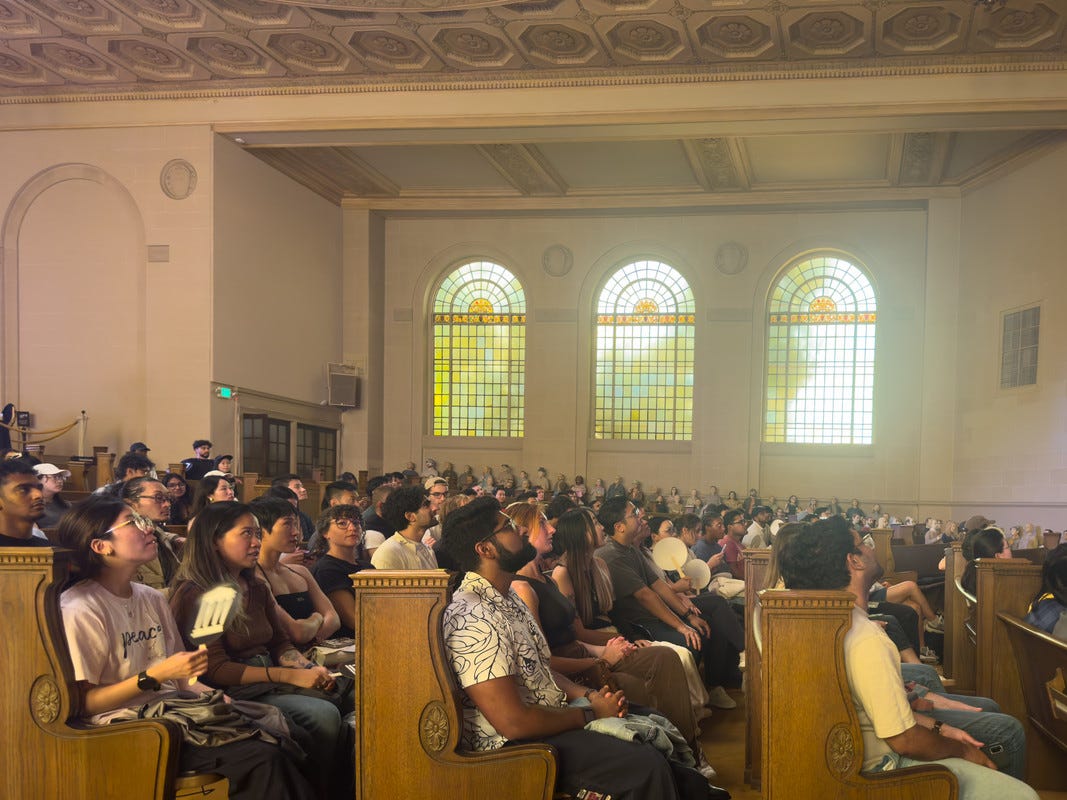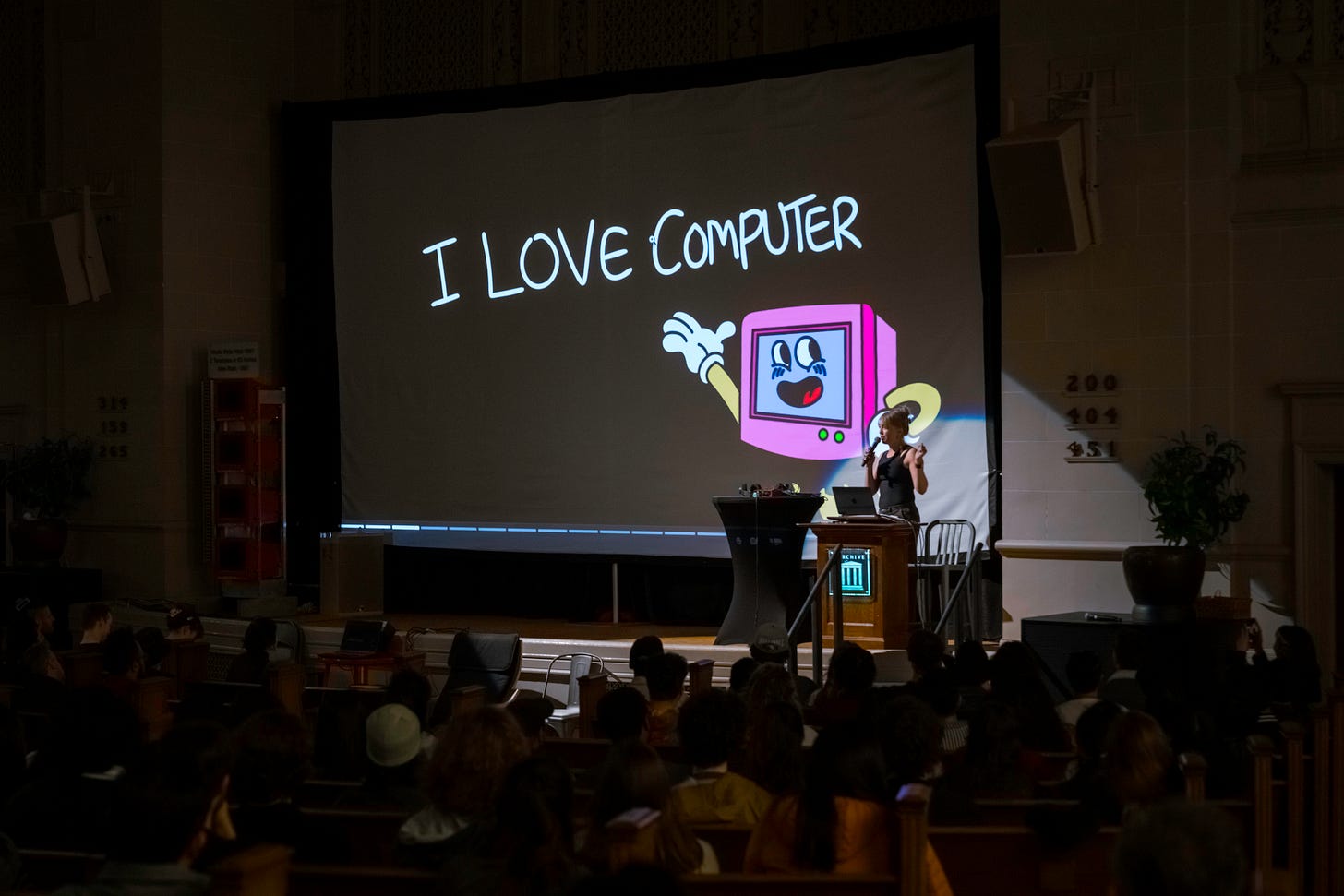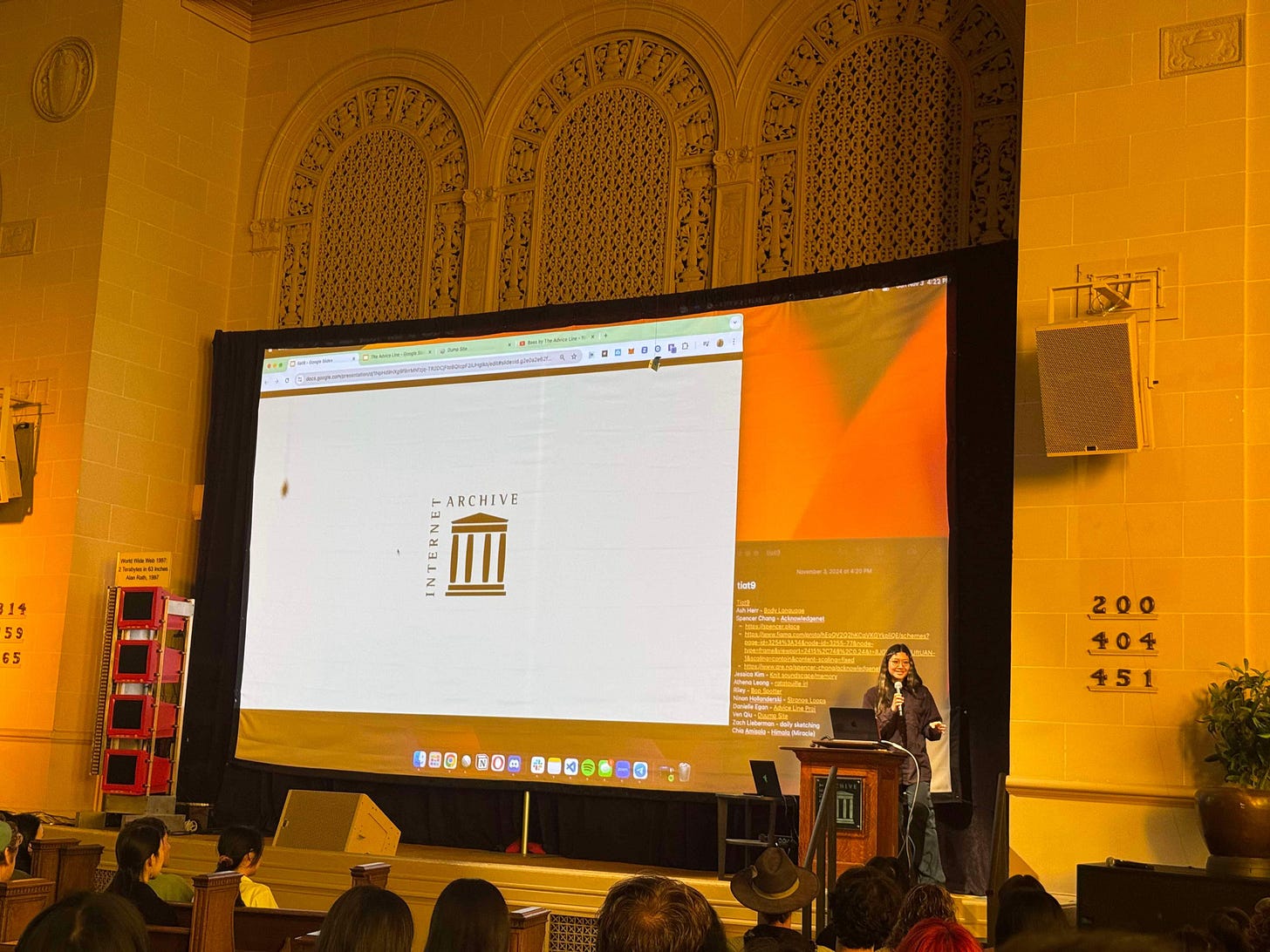Welcome to the intersection of art and technology
Ash Herr, who also goes by EMPOWA online, on cultivating a space for creative technologists and how her own projects explore authenticity and play online.
This issue of PHONE TIME includes: a look inside tiat, “the intersection of art & technology,” started by Ash Herr, which hosts salons for creative technologists in San Francisco. Plus, I spoke with Herr, who also goes by EMPOWA online, about some of her own projects.
Inside the old church building that the Internet Archive calls home, pews filled as people gathered to watch presentations of new media projects. The lineup included a digital pet called “the little guy,” a game called “The Ratchelor” that is like “The Bachelor” but with rats, and a Roomba that you can drive while it streams live on Twitch.
While you might think of a demo night in San Francisco as full of startups and companies, both are off-limits here. This is for artists.
Welcome to the intersection of art and technology, or tiat. Started by Ash Herr—who also goes by EMPOWA online—as a way to meet other creative technologists and new media artists, tiat has hosted 11 salons so far, with the last several at the Internet Archive. More than 100 total works have been presented, spanning and often combining mediums including poetry, archives, photography, music, games, code, hardware, net art, and more.

“It’s been really beautiful, and it’s just shown me that people want more creative technology spaces,” Herr said. She added that she hopes to expand tiat, seeking funding to become a 501(c)(3) nonprofit and to support more initiatives.
Herr noted the need for more creative technology infrastructure in San Francisco, particularly as mainstream tech culture has taken over and priced out many people who don’t work in tech.
That infrastructure, she said, looks like “creating more programs where people can develop their practice, exhibitions, and showcases where people can share their work,” as well as “incubators, grants, fellowships where you can get capital to invest in the ideas that you want to bring to life.” She also wants to organize other cultural artifacts like festivals and fairs.
In hoping to “create more spaces for people to gather around novel ideas that use new technologies,” Herr looks to the culture around early computing. She names the Homebrew Computer Club and the Whole Earth Catalog as specific inspirations.

The tiat website also curates other art and technology events in San Francisco. One of these is the upcoming final showcase for “Fidget Camp,” taking place June 28–29. Now in its second year, Fidget Camp is a “weeklong makeathon in San Francisco for DIY creative exploration,” with Herr as one of the “camp counselors.”
You can find tiat at tiat.place and Instagram. Recordings of recent salons are available on tiat’s YouTube channel.
💻🪞💿 Enjoy this playlist, “songs about computer,” which Herr plays at the tiat salons as people enter and leave. 💿🪞💻
Wikipedia rabbit holes, hearts around the world, music therapy, and more: some projects by EMPOWA
As EMPOWA, many of Herr’s projects have an interactive or immersive component. “Interactive installations are really fascinating to me because you, as the participant, kind of become a part of the art in some way,” she told me. “It becomes an experience that you can engage with, and it reflects you, which I find really beautiful.”
Other common threads in Herr’s work include play, empowerment, evolution, and what it means to become a more authentic version of yourself and unleash your inner child.
“music is my therapist”

On musicismytherapist.com, “you’re in the chair.” Simply type in your emotions or thoughts and receive a song to help you navigate whatever you’re feeling. I tried out a few phrases, based on some recent emotions.
Typing in “creative restlessness” returned “Sleep on the Floor” by The Lumineers. When I put in “transformation,” I got “Changes” by David Bowie. Typing in “a feeling I can’t explain” returned “Both Sides Now” by Joni Mitchell.
Like a real therapist’s office, the site is also decorated with items like a plant, lamp, books, and fidget spinner, which you can click on and interact with.
The site is “my intention of creating a space on the internet,” Herr said. “Trying to make it more tactile.”
“Heartspotting”

Heartspotting is a global archive of hearts that people have spotted. The site includes both a map and a feed of the latest images as they are uploaded. At the time of publishing, 810 hearts have been spotted in 593 locations: in lakes, kiwi, clouds, coffee, love locks, cherries, sand, spray paint, puddles, the subway. There is also a heartspotting Instagram account.
Herr connects heartspotting to the Baader-Meinhof phenomenon—“where when you start looking for something, you start to see it everywhere”—noting how the practice might put people in a more positive frame of mind.
“The practice of synchronicity, at large, I think, is a really beautiful thing,” she said.
“mirror, mirror”
“mirror, mirror” is an online installation that captures your image and translates it into the Chinese characters 见钟情, meaning “love at first sight.”
Herr made the installation as “a criticism on East Asian Orientalism and growing up seeing Asianness being hypersexualized,” she said. “And this is reclaiming that—见钟情 means ‘love at first sight,’ and so it’s kind of a cheeky way of being like, ‘Okay, I see myself reflected in this Orientalist way, and I love it.’”
“you’re never lonely on wikipedia”



“you’re never lonely on wikipedia” is a Chrome extension that will show you how many people have visited a Wikipedia page, both the day before and since 2015. The project is a reflection on how—even if you feel lonely online—many people have gone down the same rabbit holes, Herr told me.
Herr has also been documenting tiat’s salons and her own projects on Instagram and TikTok, @empowa on both platforms. “I do think it’s important as a creator to share your work online,” she said. “Personally, I feel like it’s a necessary thing to do. I want to share my work with others and see how that resonates.”
It’s safe to say it has resonated: many of Herr’s videos have racked up tens of thousands to hundreds of thousands of views and numerous “this is so cool!” comments.
“I love the internet. I feel like my favorite place to be is online,” Herr said. She added that despite the internet’s potential for toxicity, as she has grown older she has been able to cultivate communities that feel safe—and overall, it’s been empowering. “The internet’s a mirror, right? [It] reflects a version of you and what you want to see in the world.”
You can find EMPOWA, Ash Herr, at imempowa.com and on Instagram and TikTok.
Elsewhere online
I started listening to “Future Knowledge,” a podcast exploring “the intersection of technology, culture, and information policy” by the Internet Archive and Authors Alliance that launched earlier this month.
“Pikai: Saving the Earth from E-Waste,” a turtle sculpture made from old electronics donated to Goodwill Stores, will be moving to the Las Vegas Natural History Museum. It was commissioned in 2021 by Meow Wolf and made by Luis Varela-Rico. — Narée Asherian, KTNV Las Vegas
“This quirky AI-powered poem prints poems, not photos” — Trevor Mogg, Digital Trends





this is quickly becoming one of my favorite newsletters here
incredible work on these